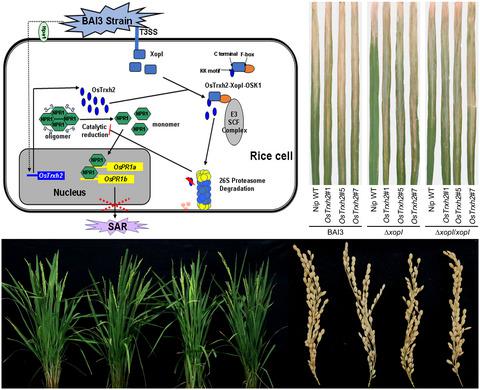Our official English website, www.x-mol.net, welcomes your
feedback! (Note: you will need to create a separate account there.)
A bacterial F-box effector suppresses SAR immunity through mediating the proteasomal degradation of OsTrxh2 in rice.
The Plant Journal ( IF 6.2 ) Pub Date : 2020-09-03 , DOI: 10.1111/tpj.14980 Hongtao Ji 1 , Delong Liu 1 , Zhaoxin Zhang 2 , Jiawen Sun 1 , Bing Han 3 , Zongyun Li 1
The Plant Journal ( IF 6.2 ) Pub Date : 2020-09-03 , DOI: 10.1111/tpj.14980 Hongtao Ji 1 , Delong Liu 1 , Zhaoxin Zhang 2 , Jiawen Sun 1 , Bing Han 3 , Zongyun Li 1
Affiliation

|
Plant bacterial pathogens usually cause diseases by secreting and translocating numerous virulence effectors into host cells and suppressing various host immunity pathways. It has been demonstrated that the extensive ubiquitin systems of host cells are frequently interfered with or hijacked by numerous pathogenic bacteria, through various strategies. Some type‐III secretion system (T3SS) effectors of plant pathogens have been demonstrated to impersonate the F‐box protein (FBP) component of the SKP1/CUL1/F‐box (SCF) E3 ubiquitin system for their own benefit. Although numerous putative eukaryotic‐like F‐box effectors have been screened for different bacterial pathogens by bioinformatics analyses, the targets of most F‐box effectors in host immune systems remain unknown. Here, we show that XopI, a putative F‐box effector of African Xoo (Xanthomonas oryzae pv. oryzae) strain BAI3, strongly inhibits the host’s OsNPR1‐dependent resistance to Xoo. The xopI knockout mutant displays lower virulence in Oryza sativa (rice) than BAI3. Mechanistically, we identify a thioredoxin protein, OsTrxh2, as an XopI‐interacting protein in rice. Although OsTrxh2 positively regulates rice immunity by catalyzing the dissociation of OsNPR1 into monomers in rice, the XopI effector serves as an F‐box adapter to form an OSK1–XopI–OsTrxh2 interaction complex, and further disrupts OsNPR1‐mediated resistance through proteasomal degradation of OsTrxh2. Our results indicate that XopI targets OsTrxh2 and further represses OsNPR1‐dependent signaling, thereby subverting systemic acquired resistance (SAR) immunity in rice.
中文翻译:

细菌F-box效应子通过介导水稻中OsTrxh2的蛋白酶体降解来抑制SAR免疫。
植物细菌病原体通常通过将多种毒力效应因子分泌并转移到宿主细胞中并抑制各种宿主免疫途径而引起疾病。已经证明,通过各种策略,宿主细胞的广泛泛素系统经常被多种病原菌干扰或劫持。已证明某些植物病原体的III型分泌系统(T3SS)效应器可模仿SKP1 / CUL1 / F-box(SCF)E3泛素系统的F-box蛋白(FBP)成分,以发挥自身的作用。尽管通过生物信息学分析已经筛选出了许多假定的类似真核生物的F-box效应子来寻找不同的细菌病原体,但是宿主免疫系统中大多数F-box效应子的靶点仍然未知。在这里,我们表明XopI是非洲人的推定F盒效应子白叶枯病(黄单胞菌PV。米曲霉)菌株BAI3,强烈抑制宿主对OsNPR1依赖性电阻致病变种。所述xopI敲除突变体显示在降低的毒力稻(米)比BAI3高。从机理上讲,我们将硫氧还蛋白OsTrxh2鉴定为水稻中与XopI相互作用的蛋白质。尽管OsTrxh2通过催化OsNPR1分解为水稻中的单体来积极调节大米的免疫力,但XopI效应子可作为F-box衔接子形成OSK1-XopI-OsTrxh2相互作用复合物,并通过OsTrxh2的蛋白酶体降解进一步破坏OsNPR1介导的抗性。 。我们的结果表明,XopI靶向OsTrxh2并进一步抑制OsNPR1依赖性信号传导,从而破坏了水稻的系统获得性抗性(SAR)免疫力。
更新日期:2020-09-03
中文翻译:

细菌F-box效应子通过介导水稻中OsTrxh2的蛋白酶体降解来抑制SAR免疫。
植物细菌病原体通常通过将多种毒力效应因子分泌并转移到宿主细胞中并抑制各种宿主免疫途径而引起疾病。已经证明,通过各种策略,宿主细胞的广泛泛素系统经常被多种病原菌干扰或劫持。已证明某些植物病原体的III型分泌系统(T3SS)效应器可模仿SKP1 / CUL1 / F-box(SCF)E3泛素系统的F-box蛋白(FBP)成分,以发挥自身的作用。尽管通过生物信息学分析已经筛选出了许多假定的类似真核生物的F-box效应子来寻找不同的细菌病原体,但是宿主免疫系统中大多数F-box效应子的靶点仍然未知。在这里,我们表明XopI是非洲人的推定F盒效应子白叶枯病(黄单胞菌PV。米曲霉)菌株BAI3,强烈抑制宿主对OsNPR1依赖性电阻致病变种。所述xopI敲除突变体显示在降低的毒力稻(米)比BAI3高。从机理上讲,我们将硫氧还蛋白OsTrxh2鉴定为水稻中与XopI相互作用的蛋白质。尽管OsTrxh2通过催化OsNPR1分解为水稻中的单体来积极调节大米的免疫力,但XopI效应子可作为F-box衔接子形成OSK1-XopI-OsTrxh2相互作用复合物,并通过OsTrxh2的蛋白酶体降解进一步破坏OsNPR1介导的抗性。 。我们的结果表明,XopI靶向OsTrxh2并进一步抑制OsNPR1依赖性信号传导,从而破坏了水稻的系统获得性抗性(SAR)免疫力。











































 京公网安备 11010802027423号
京公网安备 11010802027423号